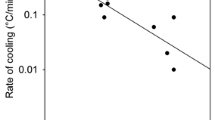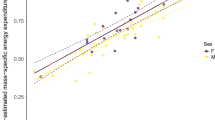Abstract
Individual-specific reaction to stressful situations may reveal various, individual-specific features, including personality. Breath rate and its change during and after handling [handling stress (HS) test] has been used to test individual response to stress. In previous laboratory research, the HS test has revealed a continuous decrease from peak values immediately after catching, which was consistent in adults of precocial and altricial species. Because of opposite trends in nestlings versus adults in altricial birds, we ask what breath rate pattern appears in precocial chicks in natural conditions? Advanced development during their early ontogeny compared to altricials could lead to breath rates similar to adults, but the effect of age, (in)experience, as well as environmental conditions, such as ambient temperature, may significantly shape breath rate patterns in chicks in different ways than in adults. In this study, we examined patterns in breath rate in response to HS in chicks of different age in a precocial wader, the Northern Lapwing (Vanellus vanellus) in the wild. Factors responsible for variation were simultaneously identified. We show that breath rate significantly dropped after visual isolation in a textile bag, a pattern similar to that in adult birds, and increased with the age of chicks as well as with higher ambient temperature. Breath rate was individually repeatable, but did not reflect individual behaviour observed before capture. Our results suggest that, when controlled for ambient temperature and time before catching, the breath rate pattern has the potential to be used as a useful HS test for neonatal Northern Lapwing chicks in the field.
Zusammenfassung
Muster in der Atemfrequenz freilebender, nestflüchtender Kiebitzküken ( Vanellus vanellus )
Individuell spezifische Reaktionen auf Stresssituationen können unterschiedliche individuell spezifische Merkmale wie Persönlichkeit aufzeigen. Die Atemrate und ihre Veränderung während und nach dem Handling (Handling-Stresstest) wurden in der Vergangenheit dazu verwendet, die individuelle Stressantwort zu testen. In früheren Untersuchungen unter Laborbedingungen hat dieser Handling-Stresstest bei adulten Vögeln von nestflüchtenden und nesthockenden Arten konsistent einen kontinuierlichen Abfall von den Höchstwerten unmittelbar nach dem Fang gezeigt. Weil Nestlinge und Altvögel bei nesthockenden Vögeln entgegengesetzte Trends aufweisen, stellt sich die Frage, welches Muster in der Atemfrequenz in Nestflüchter-Küken unter natürlichen Bedingungen auftreten. Ein Entwicklungsvorsprung gegenüber Nesthockern während der früheren Ontogenese könnte zu ähnlichen Atemfrequenzen wie bei Altvögeln führen, aber der Effekt von Alter, (mangelnder) Erfahrung sowie Umweltbedingungen wie der Umgebungstemperatur könnte die Atemfrequenzmuster der Küken deutlich anders als die der Altvögel beeinflussen. In der vorliegenden Studie untersuchten wir die Atemfrequenz als Antwort auf Handling-Stress bei unterschiedlich alten Kiebitzküken (Vanellus vanellus), einer nestflüchtenden Watvogelart. Gleichzeitig bestimmten wir die Faktoren, die für die Variation verantwortlich waren. Wir zeigen, dass die Atemfrequenz nach visueller Isolation in einem Beutel deutlich abfiel, ein Muster vergleichbar mit dem der Altvögel, wohingegen sie mit dem Alter der Küken und mit erhöhter Umgebungstemperatur zunahm. Die Atemfrequenz war individuell wiederholbar, spiegelte aber nicht das vor dem Fang beobachtete, individuelle Verhalten wieder. Unsere Ergebnisse legen nahe, dass das Atemfrequenzmuster das Potential hat, als ein nützlicher Freilandtest für Handling-Stress bei frisch geschlüpften Kiebitzküken verwendet zu werden, wenn man die Umgebungstemperatur und die Zeit vor dem Fang kontrolliert.




Similar content being viewed by others
References
Angelier F, Parenteau C, Ruault S, Angelier N (2016) Endocrine consequences of an acute stress under different thermal conditions: a study of corticosterone, prolactin, and thyroid hormones in the pigeon (Columba livia). Comp Biochem Phys A 196:38–45
Ball NJ, Amlaner CJ (1980) Changing heart rates of Herring Gulls when approached by humans. In: Amlaner CJ, MacDonald DW (eds) A handbook on biotelemetry and radio tracking. Pergamon, Oxford
Bates D, Maechler M, Bolker B, Walker S (2015) Fitting linear mixed-effects models using lme4. J Stat Softw 67:1–48. https://doi.org/10.18637/jss.v067.i01
Beintema AJ, Visser GH (1989) Growth parameters in chicks of charadriiform birds. Ardea 77:169–180
Brent R, Rasmussen JG, Bech C, Martini S (1983) Temperature dependence of ventilation and O2-extraction in the Kittiwake, Rissa tridactyla. Experientia 39(10):1092–1093
Brent R, Pedersen PF, Bech C, Johansen K (1984) Lung ventilation and temperature regulation in the European Coot Fulica atra. Physiol Zool 57(1):19–25
Brommer JE, Kluen E (2012) Exploring the genetics of nestling personality traits in a wild passerine bird: testing the phenotypic gambit. Ecol Evol 2(12):3032–3044
Bucher TL, Bartholomew GA (1986) The early ontogeny of ventilation and hemeothermy in an altricial bird, Agapornis reseicollis (Psittaciformes). Resp Physiol 65(2):197–212
Cabanac M, Aizawa S (2000) Fever and tachycardia in a bird (Gallus domesticus) after simple handling. Physiol Behav 69(4):541–545
Cabanac AJ, Guillemette M (2001) Temperature and heart rate as stress indicators of handled Common Eider. Physiol Behav 74(4):475–479
Carere C, van Oers K (2004) Shy and bold Great Tits (Parus major): body temperature and breath rate in response to handling stress. Physiol Behav 82(5):905–912
Cockrem JF, Silverin B (2002) Sight of a predator can stimulate a corticosterone response in the Great Tit (Parus major). Gen Comp Endocr 125:248–255
Cramp S, Simmons KEL (1983) Handbook of the birds of Europe, the Middle East, and North Africa: the birds of the Western Palearctic, vol III: waders to gulls. Oxford University Press, Oxford
Crawley MJ (2013) The R book, 2nd edn. Wiley, Chichester
Dallman MF, Akana SF, Scribner KA, Bradbury MJ, Walker CD, Strack AM, Cascio CS (1992) Stress, feedback and facilitation in the hypothalamo-pituitary-adrenal axis. J Neuroendocrinol 4:517–526
David M, Auclair Y, Dechaume-Moncharmont FX, Cézilly F (2011) Handling stress does not reflect personality in female Zebra Finches (Taeniopygia guttata). J Comp Psychol 126:10–14
de Bruijn R, Romero LM (2011) Behavioral and physiological responses of wild-caught European Starlings (Sturnus vulgaris) to a minor, rapid change in ambient temperature. Comp Biochem Phys A 160:260–266
Dingemanse NJ, Dochtermann NA (2013) Quantifying individual variation in behaviour: mixed-effect modelling approaches. J Anim Ecol 82(1):39–54
Dingemanse NJ, Wolf M (2013) Between-individual differences in behavioural plasticity within populations: causes and consequences. Anim Behav 85:1031–1039
Fair JM, Jones J (eds) (2010) Guidelines to the use of wild birds in research. Ornithological Council, Washington, DC
Fisher DN, James A, Rodriguez-Munoz R, Tregenza T (2015) Behaviour in captivity predicts some aspects of natural behaviour, but not others, in a wild cricket population. Proc R Soc B. https://doi.org/10.1098/rspb.2015.0708
Fucikova E, Drent PJ, Smits N, van Oers K (2009) Handling stress as a measurement of personality in Great Tit nestlings (Parus major). Ethology 115:366–374
Groothuis TGG, Carere C (2005) Avian personalities: characterization and epigenesis. Neurosci Biobehav R 29:137–150
Impekoven M (1976) Prenatal parent-young interactions in birds and their long-term effects. Adv Stud Behav 7:201–253
Kluen E, Siitari H, Brommer JE (2014) Testing for between individual correlations of personality and physiological traits in a wild bird. Behav Ecol Sociobiol 68:205–213
Koolhaas JM, Korte SM, De Boer SF, Van Der Vegt BJ, Van Reenen CG, Hopster H, De Jong IC, Ruis MA, Blokhuis HJ (1999) Coping styles in animals: current status in behavior and stress-physiology. Neurosci Biobehav R 23(7):925–935
Korneeva EV, Aleksandrov LI, Golubeva TB, Raevskii VV (2006) Development of the auditory sensitivity and formation of the acoustically guided defensive behavior in nestlings of the Pied Flycatcher Ficedula hypoleuca. J Evol Biochem Phys 42:691–698
Korte SM, Ruesink W, Blokhuis HJ (1998) Heart rate variability during manual restraint in chicks from high- and low-feather pecking lines of laying hens. Physiol Behav 65(4):649–652
Kubelka V, Zámečník V, Šálek M (2012) Přímá ochrana hnízd čejky chocholaté (Vanellus vanellus)—metodika pro rok 2012. Vanellus—Zpravodaj Skupiny Pro Výzkum Ochranu Bahňáků ČR 7:66–75
Love OP, Bird DM, Shutt LJ (2003) Corticosterone levels during post-natal development in captive American Kestrels (Falco sparverius). Gen Comp Endocrinol 130:135–141
Lynn SE, Kern MD (2014) Environmentally relevant bouts of cooling stimulate corticosterone secretion in free-living Eastern Bluebird (Sialia sialis) nestlings: potential links between maternal behavior and corticosterone exposure in offspring. Gen Comp Endoc 196:1–7
Nakagawa S, Schielzeth H (2010) Repeatability for Gaussian and non-Gaussian data: a practical guide for biologists. Biol Rev 85:935–956
Pearson JT, Tsudzuki M, Nakane YO, Akiyama RY, Tazawa HI (1998) Development of heart rate in the precocial King Quail Coturnix chinensis. J Exp Biol 201(7):931–941
R Core Team (2014) R: a language and environment for statistical computing. R Foundation for Statistical Computing, Vienna
Reeder DM, Kramer KM (2005) Stress in free-ranging mammals: integrating physiology, ecology, and natural history. J Mammal 86(2):225–235
Romero LM (2004) Physiological stress in ecology: lessons from biomedical research. Trends Ecol Evol 19(5):249–255
Rydéan OO (1982) Selective resistance to approach: a precursor to fear responses to an alarm call in Great Tit nestlings Parus major. Dev Psychobiol 15:113–120
Sapolsky RM, Romero LM, Munck AU (2000) How do glucocorticoids influence stress responses? Integrating permissive, supppressive, stimulatory, and preparative actions. 1. Endocrine Rev 21:55–89
Sordahl TA (1982) Antipredator behavior of American Avocet and Black-necked Stilt chicks. J Field Ornithol 53(4):315–325
Starck JM, Ricklefs RE (1998) Patterns of development: the altricial-precocial spectrum. In: Starck JM, Ricklefs RE (eds) Avian growth and development: evolution within the altricial-precocial spectrum. Oxford University Press, Oxford
van Oers K, Carere C (2007) Long-term effects of repeated handling and bleeding in wild caught Great Tits Parus major. J Ornithol 148:185–190
van Paassen AG, Veldman DH, Beintema AJ (1984) A simple device for determination of incubation stages in eggs. Wildfowl 35:173–178
Visser GH, Ricklefs RE (1993) Development of temperature regulation in shorebirds. Physiol Zool 66(5):771–792
Walters JR (1990) Anti-predatory behavior of lapwings: field evidence of discriminative abilities. Wilson Bull 102:49–70
Zhao QS, Hu YB, Liu PF, Chen LJ, Sun YH (2016) Nest site choice: a potential pathway linking personality and reproductive success. Anim Behav 118:97–103
Acknowledgements
Permission to capture, handle, and ring wild Northern Lapwing chicks was granted by the Bird Ringing Centre under National Museum, Prague (Krouzkovaci Stanice Narodniho Muzea, Praha), licence number 1165. This study was funded by the Internal Grant Agency of the Faculty of Environmental Sciences of the Czech University of Life Sciences (project no. 20154238). The authors thank Mark Sixsmith for his linguistic advice.
Author information
Authors and Affiliations
Corresponding author
Additional information
Communicated by L. Fusani.
Rights and permissions
About this article
Cite this article
Karlíková, Z., Kejzlarová, T. & Šálek, M. Breath rate patterns in precocial Northern Lapwing (Vanellus vanellus) chicks in the wild. J Ornithol 159, 555–563 (2018). https://doi.org/10.1007/s10336-017-1517-9
Received:
Revised:
Accepted:
Published:
Issue Date:
DOI: https://doi.org/10.1007/s10336-017-1517-9




